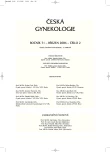Embryo Quality Evaluation According to the Speed of the first Cleavage after Conventional IVF
Kvalita embryí po klasickém IVF v závislosti na rychlosti nástupu prvního buněčného dělení
Cíl studie:
Zhodnotit kvalitu embryí po klasickém IVF v závislosti na rychlosti nástupu prvního buněčného dělení.
Typ studie:
Prospektivní studie.
Název a sídlo pracoviště:
Centrum asistované reprodukce, Por.-gyn. klinika FN a LF UP, Olomouc.
Metodika:
Bylo hodnoceno 549 embryí získaných v cyklech z klasického IVF v období 2001-2004. Kontrola nástupu prvního buněčného dělení probíhala za 24 – 27 hod. od inseminace a embrya byla rozdělena do tří skupin podle rychlosti dělení: early cleavage (EC) embrya, jestliže u nich již proběhlo první buněčné dělení, break down pronuclear (BDPN) embrya, u kterých došlo pouze k rozpuštění karyolemy a pronuclear (PN) embrya, která zůstávala ve stadiu prvojader. Stupeň fragmentace byl v těchto skupinách hodnocen 2. den kultivace ve čtyřech kategoriích: A – embrya s pravidelnými blastomerami, bez fragmentací, B – embrya s nepravidelnými blastomerami nebo s fragmentací do 30 %, C – embrya s fragmentací 30 – 50 % a D – embrya s fragmentací nad 50 %. U všech sledovaných embryí byla hodnocena rychlost dalšího dělení a průměrný počet blastomer 2. a 3. den kultivace. Statistické zpracování bylo provedeno v Centru výpočetní techniky UP Olomouc pomocí dvouvýběrového t testu a χ2 testu.
Výsledky:
Z 549 embryí bylo 45,5 % embryí EC, 33,5 % BDPN a 21,0 % PN. Zjištěné rozdíly ve stupni fragmentace mezi skupinami byly statisticky průkazné (p = 0,000). EC embrya byla v 64 % zcela bez fragmentů, zatímco téměř 50 % PN embryí bylo s vysokým stupněm fragmentace. K zástavě dělení došlo pouze ve skupině PN embryí (3,5 %). V rychlosti dělení (2. i 3. den kultivace) je rozdíl mezi skupinami statisticky průkazný (p = 0,000). Průměrný počet blastomer 2. den kultivace je statisticky průkazný mezi EC a BDPN vs. PN (p = 0,000), třetí den je průkazný rozdíl již mezi všemi skupinami (p = 0,000).
Závěr:
Hodnocení rychlosti nástupu prvního buněčného dělení je vhodným parametrem při výběru embrya k přenosu. EC embrya jsou embrya s „lepší“ morfologií a mají větší průměrný počet blastomer než obě zbývající skupiny.
Klíčová slova:
„early cleavage“ embrya, selekce embryí, morfologie embryí, in vitro fertilizace
Authors:
J. Březinová 1; M. Svobodová 1; I. Oborná 1; H. Fingerová 1; J. Dostál 1
; M. Kršková 2
Authors‘ workplace:
Centrum asistované reprodukce, Porodnicko-gynekologická klinika FN a LF UP, Olomouc
přednosta prof. MUDr. M. Kudela, CSc.
1; Centrum výpočetní techniky UP Olomouc, ředitel RNDr. F. Zedník
2
Published in:
Ceska Gynekol 2006; 71(2): 105-110
Category:
Original Article
Overview
Objective:
To evaluate morphological parametres of embryos obtained in the process of conventional IVF.
Design:
A prospective study.
Setting:
Centre of Assisted Reproduction, Dept. of Obstetrics and Gynecology, Palacký University Medical School, Olomouc.
Methods:
In the present study 549 embryos developing after conventional IVF in the period of 2001-2004 were evaluated. The beginning of the mitotic cleavage was assessed within the interval of 24 – 27 hours after insemination. The embryos were divided into three groups according to the speed of their divisionas early cleavage (EC) embryos, where two blastomeres were present at the time of assessment, break down pronuclei stage (BDPN) where the pronuclei had already disappeared, and pronuclei (PN) embryos, where both pronuclei were still present. In these groups the degree of fragmentation was evaluated on day two of cultivation and embryos were divided into four categories as: A – with regular blastomeres, without fragmentation, B - with irregular blastomeres or with fragmentation below 30%, C - with fragmentation 30-50%, D - with fragmentation above 50%. The speed of further cleavage and average number of blastomeres were evaluated on days two and three of cultivation. Statistical analysis was preformed in the Palacký University Computer Centre. The chi-square test and t test for independent samples were used.
Results:
EC embryos were found in 45.5%, BDPN in 33.5% and PN in 21.0%. EC embryos were less fragmented (p = 0.000), had more blastomeres at the time of evaluation (p = 0.000) and their speed of cleavage was faster (p = 0.000). The cleavage of EC embryos was faster in comparisson with the PN group (p = 0.000), but there were no significant differences between the EC and BDPN groups on day two of cultivation. On day three significant difference was found also between the EC and BDPN groups (p = 0.000).
Conclusion:
The speed of the first cell cleavage is a useful additional criterion for the embryo selection for ET. EC embryos usually have better morphology and more blastomeres that the BPDN and PN ones.
Key words:
„early cleavage“ embryos, embryo selection, embryo quality and viability, in vitro fertilization
Labels
Paediatric gynaecology Gynaecology and obstetrics Reproduction medicineArticle was published in
Czech Gynaecology

2006 Issue 2
Most read in this issue
- Embryo Quality Evaluation According to the Speed of the first Cleavage after Conventional IVF
- Serum Amyloid A as an Effective Marker for the Assessment of Surgical Trauma and Risk of Post-operative Complications
- Radical Parametrectomy in Women with Invasive Cervix Cancer after Previous Simple Hysterectomy
- Ursodeoxycholic Acid, S-adenosyl-L-methionine and their Combinations in the Treatment of Gestational Intrahepatic Cholestasis (ICP)
